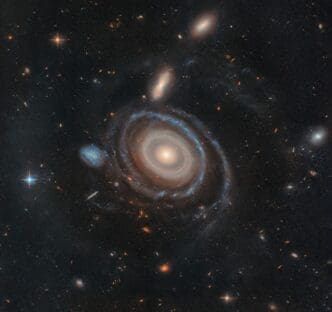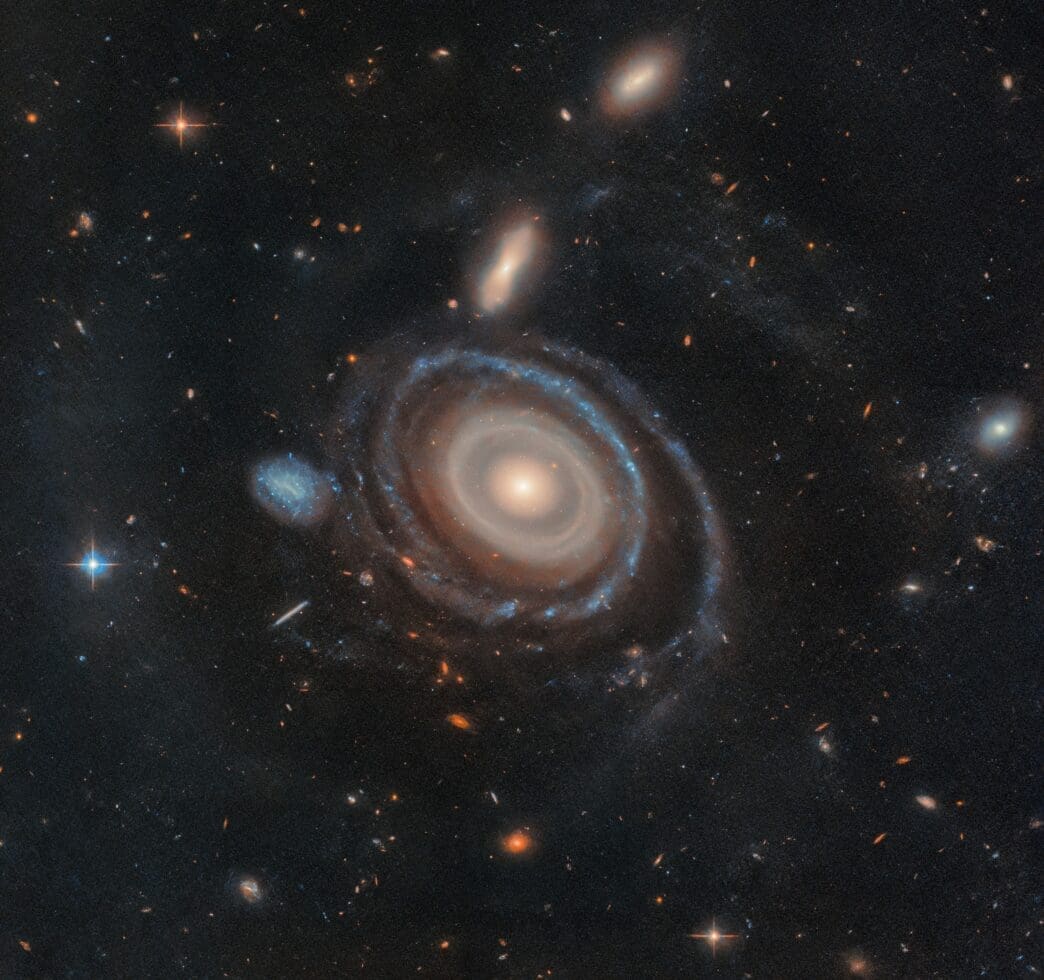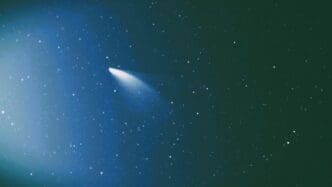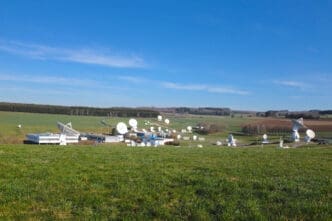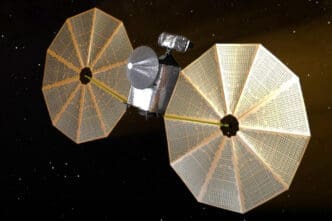NASA’s Hubble Space Telescope captured an image that’s out of this world!
Released on February 4, 2025, it presents the massive galaxy LEDA 1313424, playfully dubbed the Bullseye.
This cosmic wonder showcases a spectacular phenomenon with nine circular rings formed by a smaller galaxy’s dramatic journey.
Join us as we explore how these stunning celestial features came to be in one of Hubble’s most riveting discoveries.
Let’s dive into this astronomical adventure!
A Cosmic Collision
A peculiar event occurred 50 million years ago in LEDA 1313424. A small blue dwarf galaxy, like an interstellar dart, pierced through the Bullseye’s center. It spun a web of nine starry rings, ensuring that this galaxy wouldn’t go unnoticed.
This cosmic collision offers a rare look at how galaxies can interact. Unlike most observed galactic rings, of which there are often only a few, Bullseye boasts a jaw-dropping eight visible rings, with a ninth confirmed through intricate data analysis.
A Closer Look with Hubble
NASA’s Hubble Space Telescope set its sights on LEDA 1313424, revealing more rings than previously seen. It’s not just a pretty picture, though. The data collected helps illuminate the mechanics of such a unique structure.
Observations from Hubble, coupled with follow-up data from the W. M. Keck Observatory, enabled scientists to spot the ninth ring. This level of detail allows researchers to discern which smaller galaxy dared to travel through the Bullseye’s core.
Through this celestial discovery, Hubble and Keck have shown how advancements in technology deepen our understanding of the universe.
This discovery marks a pivotal point in our journey to unravel the mysteries of galactic interactions.
An Interstellar Rarity
The blue dwarf’s path through the Bullseye is an intergalactic spectacle. Most galaxies don’t flaunt such extensive ring systems, certainly not nine!
Typically, galaxies merge or collide in a complex dance that rarely leaves behind more than two or three rings. But this sequence, likened to ripples on a pond, is extraordinarily rare.
The gravity of this interaction links the galaxies in a cosmic bond, separated now by a vast expanse of space.
The Significance of Rings
Each ring within LEDA 1313424 tells a story of cosmic impact and attraction. Knowing why and how these rings form is key to understanding galactic evolution.
The Bullseye’s rings provide a spectacular laboratory for studying galactic collisions. By diving into these findings, astronomers can refine models of how galaxies grow and evolve over time.
This isn’t just about the visual marvel of rings but their history and what they reveal about galactic processes.
Data from the Cosmos
Hubble and Keck Observatory data detail the Bullseye’s structure like never before. Spotting the ninth ring was a breakthrough, achieved through meticulous observation and analysis.
The findings not only challenge previous notions of ring formation but invite further research on similar phenomena across the universe. Such discoveries push the boundaries of our knowledge.
Understanding these cosmic echoes allows scientists to reconstruct the history of galactic dynamics. It paints a vivid picture of the forces at play in the vast expanse of space.
Implications for Future Exploration
These findings catalyze future astronomical explorations. Understanding such cosmic events sheds light on the past, present, and future of our universe.
The Bullseye offers a perfect backdrop for testing new technologies and theories on galactic structure. As our instruments evolve, so does our insight into the cosmos.
Such discoveries remind us of the vastness and complexity of the universe, driving our quest for knowledge and exploration.
NASA’s mission to explore unknown realms continues. Every new discovery opens pathways to more questions, more mysteries to unravel.
Galaxies in Motion
The Bullseye’s intricate rings highlight the dynamic nature of galaxies. They’re not static entities but are in constant interaction and evolution.
Each interaction, like the one within LEDA 1313424, is part of a grander cosmic ballet that shapes the universe.
By studying these processes, we gain insights into the past and future of galaxies. Each piece of new information adds to the cosmic puzzle.
As observers from Earth, these galactic events expand our understanding and imagination. Discoveries like these inspire generations to reach for the stars.
The Road Ahead
The journey doesn’t end with the discovery of the Bullseye’s rings. It sets the stage for future observations and technological advancements.
With each leap forward in telescope technology, we peel back layers of the unknown, uncovering the rich tapestry of the cosmos.
Astronomers are optimistic about what the next decade holds for galactic research. Who knows what groundbreaking discoveries await?
The Celestial Connection
LEDA 1313424 and its rings demonstrate the interconnectedness of the universe. Every cosmic event is wrapped in layers of complexity and wonder.
As we decode these celestial messages, the story of our universe continues to unfold, each chapter more thrilling than the last.
It’s a testament to the unending quest for knowledge that fuels astronomers and captivates enthusiasts worldwide.
The Bullseye galaxy is a stellar example of the universe’s ever-evolving narrative, an invitation to curiosity.
As our tools and understanding improve, we remain on the edge of discovery, ready to explore what lies beyond. It’s a journey that is far from over.

